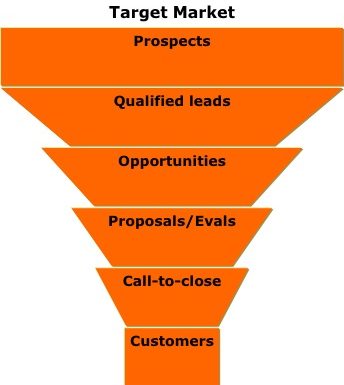 In my last post, I looked at the reason that marketing and sales don’t get along. While communication is the biggest issue, both parties also need to speak the same language. For me, the sales funnel can be the dictionary that aligns sales and marketing.
In my last post, I looked at the reason that marketing and sales don’t get along. While communication is the biggest issue, both parties also need to speak the same language. For me, the sales funnel can be the dictionary that aligns sales and marketing.
Moving leads through the funnel is crucial to any successful marketing campaign and more importantly to the company’s ability to sell more products. But before we talk about that process, the first step is for sales and marketing to work together and define the stages of the sales funnel for their organizations.
While the concept is similar across most sales funnels, it’s not always the same. In general, the stages of the sales funnel may include: prospects, qualified leads, sales opportunities, proposals/evaluations, call-to-close and customer phases (as illustrated in the graphic). Neither the number of stages nor the names are what’s important here though.
What is crucial is that sales and marketing agree on the stages and the names so they are speaking the same language. And, above all else, agreement on the stage where marketing passes leads to sales and the definition of these qualified leads is imperative. I’ll talk more about defining each stage of the sales funnel in the next blog post.
Once the stages are agreed to, then it’s important to understand the number of prospects that become leads (10-20%) and the ratio of qualified leads to closed deals (15:1-20:1) so that marketing can generate sufficient leads to meet the revenue requirements for the year. Of equal importance, you need to understand the time it takes to move from one stage to the next (1 to 2 months per stage depending on target market and the maturity of it).
While everyone would love these ratios and timelines to be smaller and shorter for their industry, I’ve seen time and time again that these are more consistent than first thought in technology companies and can be even longer when selling to certain verticals.
However, the only way to truly measure these ratios is to carefully track leads throughout the process which once again points to how marketing and sales need to communicate. But, it’s pointless to use unrealistic ratios or timelines when planning your campaign or sales projections.
At the outset, it’s more important that sales and marketing agree on the definitions and timing until the data is available to prove or disprove the assumptions. You can adjust the ratios and timings when you have concrete metrics and evidence built by carefully tracking this information.
In the end, and I’ve said it many times, the number and name of the stages are not what’s important. What is important is that marketing and sales agree on ALL of it and also what it takes to move a lead from one stage to the next. While funnels will vary between different industries and organization, it must NOT vary within the organization.


Leave a Reply